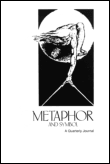
METAPHOR AND SYMBOL
Scope & Guideline
Advancing Insights in Communication and Cognition
Introduction
Aims and Scopes
- Cognitive Linguistics and Metaphor:
The journal emphasizes the cognitive aspects of metaphor usage, investigating how metaphors influence thought processes, reasoning, and emotional responses. - Multimodal Metaphor Analysis:
Research often incorporates visual and multimodal elements, analyzing how metaphor transcends verbal language to include images, gestures, and other forms of communication. - Cultural and Contextual Studies of Metaphor:
The journal explores metaphors within specific cultural and social contexts, studying how cultural narratives shape metaphorical expressions and their interpretations. - Interdisciplinary Approaches to Metaphor:
The journal promotes interdisciplinary research, bridging linguistics, psychology, literature, and social sciences to provide a holistic view of metaphor's role in human cognition and culture. - Methodological Innovations:
There is a consistent focus on developing new methodologies for analyzing metaphors, including computational and qualitative approaches, enhancing the rigor of metaphor studies.
Trending and Emerging
- COVID-19 and Metaphor:
A significant trend is the exploration of metaphors related to the COVID-19 pandemic, examining how language shapes public perception and response to health crises. - Emotional and Psychological Impacts of Metaphor:
Increasing attention is being given to the emotional and psychological dimensions of metaphor usage, particularly in contexts of trauma, mental health, and personal narratives. - Visual and Multimodal Metaphors:
There is a growing interest in visual and multimodal metaphors, reflecting how different forms of communication interact and convey meaning in contemporary discourse. - Metaphor in Digital Communication:
Research is increasingly focusing on metaphors in digital contexts, such as social media and online discourse, highlighting their role in shaping public narratives and identity. - Methodological Advances in Metaphor Research:
Emerging methodologies, such as corpus-based analyses and computational approaches, are gaining traction, reflecting a shift towards more empirical and data-driven studies in metaphor research.
Declining or Waning
- Traditional Literary Metaphor Analysis:
Research focusing solely on traditional literary metaphors, such as those found in poetry and prose, appears to be waning in favor of more cognitive and contextual approaches. - Static Metaphor Studies:
There is a noticeable reduction in studies that treat metaphors as fixed entities, moving instead towards dynamic analyses that consider metaphor's evolution and contextual variability. - Historical Metaphor Comparisons:
Studies comparing historical metaphors across time periods are becoming less frequent, with a shift towards contemporary applications and immediate cultural relevance. - Simplistic Interpretations of Metaphor:
The journal seems to be moving away from simplistic or reductive interpretations of metaphor, favoring more nuanced and comprehensive analyses that consider multiple layers of meaning.
Similar Journals
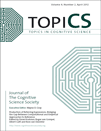
Topics in Cognitive Science
Exploring the Intersection of Mind and TechnologyTopics in Cognitive Science, published by WILEY, is a premier interdisciplinary journal that advances the understanding of the cognitive processes that underpin human behavior and interaction with technology. With a commendable impact factor and a strong focus on research from 2009 to 2024, this journal garners significant attention in various subfields, as evidenced by its Q1 ranking in Experimental and Cognitive Psychology and Linguistics and Language, alongside a Q2 position in Artificial Intelligence, Cognitive Neuroscience, and Human-Computer Interaction. Researchers and professionals will find invaluable insights into the latest experimental findings, theoretical discussions, and practical applications that bridge cognitive neuroscience, psychology, and computer science. Topics in Cognitive Science is especially pivotal for those aiming to delve deeper into cognitive mechanisms and their implications within our increasingly digital world, making it an essential resource for students and scholars alike.
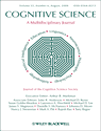
COGNITIVE SCIENCE
Pioneering Research in the Realm of CognitionCOGNITIVE SCIENCE, published by WILEY, is a leading academic journal that delves into the complexities of human cognition through an interdisciplinary lens. With an ISSN of 0364-0213 and an E-ISSN of 1551-6709, this journal has made significant strides in the field since its inception in 1977, ample coverage through to 2024, and a commendable Q1 and Q2 categorization in Experimental and Cognitive Psychology and Cognitive Neuroscience as of 2023. The journal is positioned at the intersection of various disciplines, ranking #65 out of 165 in Experimental and Cognitive Psychology and #58 out of 115 in Cognitive Neuroscience, highlighting its relevance and contribution to advancing knowledge in these areas. Although it does not offer open access, COGNITIVE SCIENCE remains an essential resource for researchers, professionals, and students seeking to explore groundbreaking research and theoretical insights within the vast domain of cognitive science.

Biolinguistics
Exploring the Nexus of Biology and LanguageBiolinguistics, published by the University of Cyprus, Department of English Studies, is a distinguished Open Access journal that has been at the forefront of exploring the intricate relationships between biology and language since its inception in 2007. With an ISSN of 1450-3417 and an impressive presence in both Experimental and Cognitive Psychology and Linguistics, this journal ranks in the Q4 and Q3 Quartiles respectively, indicating its significant contribution to these fields. Situated in Nicosia, Cyprus, the journal aims to bridge interdisciplinary gaps, drawing insights from cognitive science, linguistics, and biological studies, making it essential reading for researchers, professionals, and students. With current Scopus rankings placing it in the 77th percentile for Language and Linguistics and a 20th percentile in Experimental and Cognitive Psychology, Biolinguistics continues to make an impactful mark on the academic community. As you delve into its enriching content, you can expect rigorous peer-reviewed articles that pave the way for innovative research and discourse within the realm of biolinguistics.
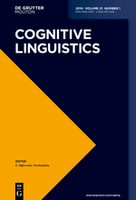
COGNITIVE LINGUISTICS
Connecting Minds: Where Language Meets Cognition.COGNITIVE LINGUISTICS, published by De Gruyter Mouton, is a premier academic journal dedicated to advancing the field of cognitive linguistics and its interconnections with psychology and language studies. With an impressive impact factor and a ranking in the Q1 category for Linguistics and Language, as well as Q2 in Developmental and Educational Psychology according to 2023 metrics, this journal demonstrates its significance in fostering scholarly discourse and innovation. The journal's rigorous peer-reviewed approach ensures that only high-quality research is shared with its audience, including professionals, researchers, and students keen on exploring the cognitive aspects of language. Since its inception in 1990, COGNITIVE LINGUISTICS has been a vital platform for disseminating cutting-edge studies, making it an invaluable resource for anyone interested in the intersections of cognitive science and linguistics.
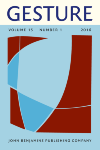
Gesture
Capturing the essence of communication beyond words.Gesture, published by JOHN BENJAMINS PUBLISHING CO, is a leading interdisciplinary journal that focuses on the study of human gestural communication as a rich field for linguistic and cognitive research. With an ISSN of 1568-1475 and an E-ISSN of 1569-9773, the journal has been influential since its inception in 2001, providing a vital forum for researchers and professionals studying the interplay between gesture and language. It significantly contributes to various academic fields, evidenced by its remarkable rankings, including Q1 in Cultural Studies and Q2 in Linguistics and Language as of 2023. While it does not offer Open Access, its high impact in scholarly communication makes it indispensable for anyone wanting to explore the nuances of non-verbal expression. The journal maintains a dynamic scope, converging scholarship from 2001 to 2014 and continuing robustly from 2016 to 2024, solidifying its position in the social sciences sector, particularly in the realms of communication, cultural studies, and cognitive psychology. Gesture is published from the Netherlands, and its esteemed reputation ensures that it attracts contributions from top-tier researchers worldwide, making it a crucial resource for advancing knowledge and understanding in the field.
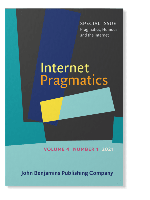
Internet Pragmatics
Unveiling the Nuances of Online InteractionInternet Pragmatics, published by John Benjamins Publishing Company, stands as an essential journal within the fields of Computer Networks and Communications and Linguistics and Language. With an ISSN of 2542-3851 and an E-ISSN of 2542-386X, it has been dedicated to exploring the nuanced interactions and societal implications enabled by the internet since its inception in 2019. The journal has quickly gained a strong academic reputation, achieving a Q3 ranking in its Computer Networks and Communications category and a prestigious Q1 ranking in Linguistics and Language for 2023, showcasing its vital contribution to interdisciplinary discourse. Researchers and professionals alike can benefit from its robust collection of articles that delve into the intersection of technology and communication, making it a pivotal resource for those keen on understanding the evolving landscape of digital interaction. Although currently available through traditional access options, the journal endeavors to broaden access, ensuring that valuable insights in this rapidly advancing field reach a wider audience.

Cognitive Semantics
Advancing Understanding of Language and ThoughtCognitive Semantics, published by BRILL, is a leading academic journal dedicated to the intricate study of cognitive processes underlying language use and semantic meaning. With its ISSN 2352-6408 and E-ISSN 2352-6416, this journal contributes significantly to the fields of linguistics and language studies, reflecting its importance in contemporary research on cognitive linguistics. Over its publication span from 2015 to 2024, it has established a niche as a Q3 ranked journal in the Linguistics and Language category for 2023, showcasing its relevance and growing influence in the academic community. Although currently not open access, the journal aims to provide a robust platform for exchanging ideas, theories, and methodologies related to cognitive semantics, fostering interdisciplinary dialogue among researchers, professionals, and students. Readers can expect to uncover valuable insights into the cognitive mechanisms that shape our understanding of language, making this journal an essential resource for anyone involved in linguistic research.

Russian Journal of Linguistics
Fostering Global Dialogue Through LinguisticsWelcome to the Russian Journal of Linguistics, a prestigious journal published by Peoples Friendship University of Russia that has made significant strides in the realm of linguistic studies since its inception. With an Open Access policy established in 2019, this journal provides unparalleled opportunities for researchers, professionals, and students to share and disseminate groundbreaking linguistic research. The journal is currently ranked in the Q1 category for Linguistics and Language and boasts impressive Scopus rankings, placing 129th out of 1088 in the Arts and Humanities, and 148th out of 1167 in the Social Sciences. Focusing on a diverse range of linguistics topics, the journal aims to facilitate cross-disciplinary dialogue and foster advancements in the study of language. Located in Moscow, Russia, it champions the vibrant linguistic community by consistently publishing high-quality research that contributes to the global understanding of language dynamics. We invite you to explore the wealth of knowledge and insight the Russian Journal of Linguistics has to offer.
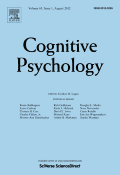
COGNITIVE PSYCHOLOGY
Leading the Way in Cognitive ResearchCOGNITIVE PSYCHOLOGY is a premier academic journal published by Academic Press Inc. Elsevier Science, specializing in the dynamic and evolving field of cognitive psychology. With a significant history spanning from 1970 to 2024, this journal has established itself as a critical resource for researchers and professionals alike, boasting a distinguished ranking in the Q1 category across multiple disciplines, including Experimental and Cognitive Psychology, Neuropsychology, and Artificial Intelligence. Its impact factor, reflective of its influence and reputation within the academic community, positions COGNITIVE PSYCHOLOGY as an essential platform for disseminating cutting-edge research and theoretical advancements. Although it is not open access, subscribers gain exclusive insights into the latest findings that drive the field forward. The journal's commitment to fostering innovative research makes it an indispensable tool for those dedicated to understanding the complexities of human cognition.
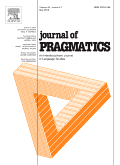
JOURNAL OF PRAGMATICS
Advancing Knowledge in Pragmatics and BeyondJournal of Pragmatics, published by Elsevier, is a premier interdisciplinary journal dedicated to the exploration of language use as a dynamic social phenomenon. Established in 1977 and set to continue through 2024, it serves as a vital resource for researchers across various fields, including Artificial Intelligence, Linguistics, and Language Studies. With an impressive Q1 ranking in Linguistics and Language and a Q2 ranking in Artificial Intelligence, the journal has made significant contributions, supporting a diverse range of theoretical and empirical research. It boasts a solid reputation, evidenced by its strong positions in Scopus rankings—occupying the 91st percentile among the best in the Social Sciences and 92nd in Arts and Humanities. Although it does not currently offer open access, the Journal of Pragmatics remains essential for professionals and scholars seeking to deepen their understanding of pragmatics and its applications in language technology, societal interaction, and cognitive processes. With its international reach and high standards, this journal is a cornerstone for anyone dedicated to advancing knowledge in the fields of language and communication.